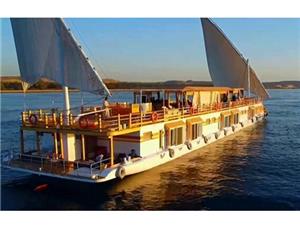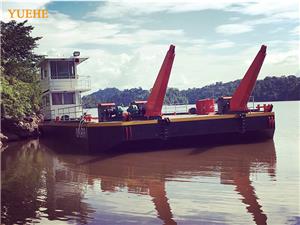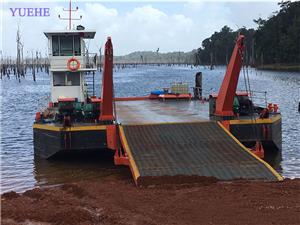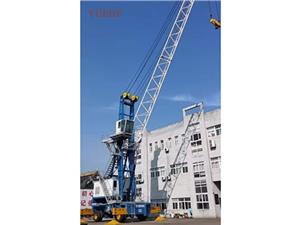The structural features and applications of the modular dredger
The modular dredger is a type of dredging equipment that adopts a modular design to separate the core functional components (such as the power system, suction device, hull, etc.) for independent division. This design facilitates transportation, assembly, and flexible operation. Its core feature is "modularity". Compared with traditional integrated dredgers, it has significant differences in structural layout, transportation methods, and adaptability to different scenarios. The following will be analyzed from the aspects of construction characteristics and application scenarios:

I. Construction Characteristics of Split-Type Dredgers
The "separate" design of the modular dredger is mainly reflected in the independence of functional modules and the standardization of connection methods. The core modules can be divided into three parts: the power station (power module), the suction device (operation module), and the carrier (support module). Each module can operate independently or be quickly combined to form a complete operation system. The specific structural features are as follows:
Modular division: Functions are independent and can be split flexibly.
The basic structure of the modular dredger is to divide the key equipment of the traditional integral dredger according to functions into three core modules:
• Power station (power module):
The core power equipment of the integrated dredger (such as diesel engines, generators, hydraulic pump sets), control systems (such as PLC or intelligent operation consoles), and auxiliary systems (such as cooling, fuel, and air compression). They are usually in container or skid-mounted structures, with light weight and compact size (approximately 6-12m × 2.5-4m × 3-4m), and can be transported by trucks, railways or small ships.
Function: To provide power for the cutter suction device (to drive the cutter to rotate and the sludge pump to discharge sludge), and integrate the operation control center.
• Suction device (operation module):
It includes components such as the cutter head, the bridge frame (the metal structure supporting the cutter), the suction pipe (the pipe connecting the cutter to the mud pump), and the lifting cylinder (used to adjust the depth of the cutter into the soil). The cutter head can be replaced according to the operation requirements (such as toothed blades, shovel-shaped blades, or roller blades). The bridge frame can be folded or extended to adapt to different water depths and bottom conditions.
Features: The modular design enables it to be transported independently of the power station (such as by flatbed truck or by floating), and during on-site assembly, it only needs to be connected to the hydraulic/mechanical interfaces of the power station.
• Carrier (Support Module):
In the split-type design of traditional dredgers, the "body" is often simplified to a support platform (such as small floating boxes, barges or land-based supports), whose main function is to provide a stable working platform for the suction device (such as horizontal support, anti-sinking). If used for waterborne operations, the carrier may be a small non-self-propelled barge (with a draft of ≤ 2m); if used on land or on shallow banks, it may be a movable steel support (secured by anchors or traveling by tracks).
2. Connection System: Quick connection, high reliability
The modules are connected through standardized interfaces to ensure the efficiency of disassembly and assembly:
• Mechanical interface: The bridge frame of the cutter suction device and the carrier (or power station) are fixed by high-strength bolts or hydraulic pins to ensure stability during operation.
• Hydraulic/Pneumatic Interface: The power station is connected to the power components of the cutter suction device (such as the cutter drive motor and the mud pump motor) via high-pressure hoses or cables. Fast-acting connectors are used to reduce the connection time.
• Control Interface: The operation console of the power station is connected to the sensors of the cutter suction device (such as the rotational speed sensor of the cutter, the pressure sensor of the mud pump) via signal lines, enabling remote centralized control.
Typical assembly time: A skilled team can complete the module connection within 2 to 6 hours (depending on the size of the modules and the complexity of the interfaces), which is much faster than the installation period of an integrated dredger (usually taking several days).
3. Lightweight Structure and Compactness
To meet the requirements of separate transportation, each module is designed with lightweight features:
• The power station is made of high-strength aluminum alloy or composite steel, which reduces its weight while maintaining strength;
The frame of the suction device is constructed using a truss structure (instead of solid steel plates), which reduces the amount of material used while maintaining rigidity.
• Key components (such as the impeller of the mud pump and the teeth of the auger) are made of high-chromium cast iron or wear-resistant alloys, which not only extends their service life but also reduces their weight.
Typical parameters: The weight of a single module of a medium-sized or small-scale modular cutter suction dredger is usually ≤ 20 tons (the power station weighs approximately 8-15 tons, and the cutter suction device weighs approximately 10-18 tons). It can be transported by ordinary trucks (such as 20-ton models) or small floating cranes.
4. Environmental Adaptability Design
The modular design is naturally well-suited for complex working environments:
• Operations in shallow waters: The carrier (such as a floating box) has a draft of only 1-2 meters, enabling operations in shallow water areas such as inland rivers, lakes, and tidal flats (while traditional integrated dredgers typically have a draft of ≥3 meters).
• Narrow spaces: The modules can be transported to narrow water areas such as between bridge piers or in corners of the docks by small vessels or by land transportation.
• Temporary Works: No need for permanent docks or large assembly sites. Only a temporarily leveled open space (such as riverbanks or tidal flats) is required for the assembly to be completed.
II. Application Scenarios of Split-Type Dredgers
The structural characteristics of the modular dredger directly determine its application direction - it is suitable for small-scale, complex terrain, and transportation-restricted dredging and reclamation projects. The following are its core application scenarios:
Dredging and maintenance of inland waterways
In inland waterways (such as the tributaries of the Yangtze River, the river network in the Pearl River Delta, and the Yellow River Basin), there are common characteristics of shallow water depth (≤5 meters) and narrow river channels (width ≤ 50 meters), as well as low navigation density. The advantages of modular dredgers are significant:
• They can be transported by land to the riverbanks and then assembled onto floating boxes using small floating cranes or tugboats;
• With a water depth of no more than 2.5 meters, operations can still be carried out close to the riverbed during the dry season (such as in winter), for the removal of accumulated silt (mainly consisting of mud and sand), and to restore the designed water depth of the channel (generally 3-4 meters).
• Highly mobile, it can be operated in sections along the river course and is capable of adapting to changes in water levels (by adjusting the buoyancy of the carrier or the anchoring position).
Typical case: The maintenance project of the waterway of a certain tributary in the middle reaches of the Yangtze River used a modular cutter suction dredger (with a cutter power of 200 kW and a mud pump flow rate of 1500 m³/h). It completed the dredging of 5 kilometers of the river channel in just one week, with an efficiency more than 10 times that of traditional manual dredging.
2. Dredging of Small Ports and Terminals
For ports with a capacity of less than 10,000 tons (such as small cargo ports in county-level economies or fishing docks), the harbor basins, anchorage areas, and the front waters of the docks often require regular maintenance due to the silt accumulation caused by the ships' navigation:
• Modular dredgers can be transported by small docks (requiring only a 20m × 10m operation space) or temporary walkways, avoiding the problem that large dredgers need to rely on deep-water docks;
The cutter can be replaced with a smaller diameter model (≤ 1.5m), which is suitable for precise dredging in narrow water areas (such as where the distance between docks is ≤ 10 meters).
By combining with a slurry separation equipment (such as a filter press), the slurry can be dehydrated and then directly disposed of as waste or used for backfilling the land area behind the wharf, thereby reducing the impact of slurry discharge on the water quality of the harbor basin.
Typical case: The dredging project of the harbor basin in a certain fishing port in the southeast coastal area used a modular dredger (with a cutterhead power of 150 kW) in conjunction with a filter press. Within two months, the dredging of three anchorage areas (with a total area of approximately 20,000 square meters) was completed. The slurry was then dehydrated and directly used for the hardening of the port area roads.
3. Land Reclamation by Dredging and Land Reclamation
For land reclamation by dredging in coastal mudflats, inland low-lying areas or abandoned ponds (such as industrial park expansion or farmland consolidation), the transportation of sediment from the sand extraction area to the filling area is required. The flexibility of modular dredgers is crucial:
• The power station and the suction device can be separately located: The suction device operates in the sand extraction area (such as the mudflat), while the power station and the mud pit are located near the filling area. They are connected by a long-distance slurry pipeline (≤ 500 meters), reducing the terrain limitations between the sand extraction area and the filling area;
• Capable of adapting to complex terrain: If there are obstacles (such as dams or buildings) between the filling area and the sand extraction area, the transportation distance of the soil can be extended by using relay pumps (by adding an intermediate power station).
• Low cost: Compared to large suction dredgers (which require transportation by large barges), the procurement and relocation costs of the modular equipment are only 1/5 to 1/3 of those of the large vessels, making it suitable for small and medium-sized land-creation projects (with land creation area ≤ 500 mu).
Typical case: An land reclamation project on a coastal tidal flat in Jiangsu Province used a modular dredger (with a cutter head power of 300 kW and a sewage pipe length of 400 meters). It completed the filling of 200 mu of low-lying land in 3 months, and the cost of land reclamation was reduced by 40% compared to traditional methods.
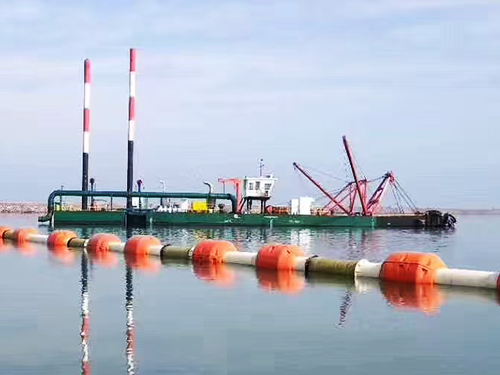
4. Hydraulic Engineering and Comprehensive River Rehabilitation
Projects in the water conservancy field such as river channel dredging, reservoir sediment discharge, and lake ecological management often require a balance between dredging efficiency and ecological protection. The structural characteristics of modular dredgers precisely match these needs:
• River channel dredging: It can reach areas that large dredgers cannot access, such as bends and under bridge piers, to remove accumulated debris (such as tree roots and mixed garbage and sand) that impede flood flow;
• Reservoir sand discharge: Using small floating containers as carriers, the dredging vessel is positioned in the dead storage area of the reservoir. The surface sediment (with a sand content of ≤ 5%) is excavated to avoid disturbing the underlying clear water.
• Lake ecological management: Use environmentally friendly augers (such as closed auger covers and anti-spread nozzles) to reduce the spread of sediment during dredging. Connect the slurry pipeline to directly transport the slurry to the designated sedimentation area, thereby minimizing secondary pollution to the lake ecosystem.
Typical case: An ecological dredging project for a lake bay in Taihu Lake used a modular environmental-friendly cutter suction dredger (with a cutter power of 250 kW and equipped with a sealed suction pipe). It successfully removed 0.8 km² of eutrophic bottom sediment (with a thickness of 0.5 - 1.2 meters), and the water transparency increased from 0.8 meters to 2.5 meters.
5. Emergency and Special Scenarios Dredging
The rapid assembly and mobility of the modular dredgers give them an irreplaceable advantage in emergency situations:
• After typhoons or heavy rains, dredging: The modules can be transported and assembled within 24 hours, quickly clearing the accumulated silt (such as trees, stones, and garbage) in the river channels and drainage ditches, preventing secondary flooding;
• Ship grounding rescue: Through precise and localized dredging (the cutter can adjust the depth of entering the soil ≤ 1.5 meters), remove the silt around the grounded ship, and assist in freeing the vessel from the moorings.
• Military/Temporary Projects: For instance, the emergency maintenance of temporary docks, the soil distribution for the runway of mobile airports - the modular dredgers can be quickly deployed (without the need for extensive construction preparations), meeting emergency requirements.
Typical case: After a typhoon hit a coastal city, a certain inland waterway was severely blocked by a large amount of floating debris and silt. A modular dredger (with a cutterhead power of 180 kW) was assembled within 48 hours and cleared 12 kilometers of the waterway in 3 days, restoring shipping operations.
III. Limitations of Split-Type Dredgers and Optimization Directions
Although the modular dredger has significant advantages, its structure also determines the operational capacity limits:
• Processing capacity is limited: Due to the power of the power station (usually ≤ 500 kW) and the flow rate of the mud pump (≤ 3000 m³/h), the daily operation volume of a single vessel is generally 500 - 2000 m³, which is difficult to meet the requirements of large-scale projects (such as coastal deep-water channels, large-scale reclamation projects);
• Poor anti-wind and wave resistance: The stability of the carrier (such as small floating boxes) is poor. When operating in winds and waves of force 6 or above, or in deep waters with a depth greater than 8 meters, the risks are relatively high.
• The level of automation needs to be improved: For some models, the depth adjustment of the cutter and the control of the mud pump speed still rely on manual operation, resulting in lower efficiency and accuracy compared to the intelligent integrated dredger.
Future optimization directions include:
• Intelligent upgrade: Integrate systems such as GPS positioning, automatic cutter depth control, and mud concentration monitoring to enhance operational accuracy and safety;
• Module standardization: Establish a unified interface standard to enable the interchangeability of modules from different brands, thereby reducing the maintenance costs for users.
• Greening improvement: Adopt electric or hybrid power stations (such as lithium batteries + diesel engines) to reduce fuel emissions; combine with equipment for slurry water separation and resource utilization (such as brick-making and pottery-making), to achieve resource utilization of waste materials.
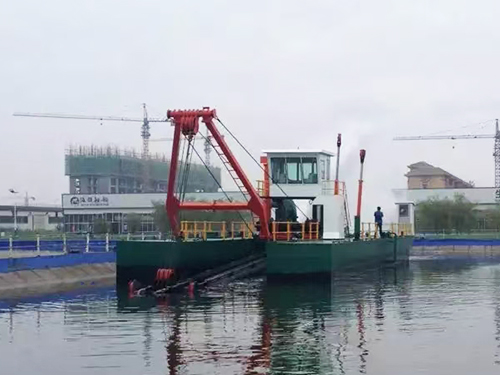
Summary
The modular dredger breaks through the transportation and application limitations of traditional integrated equipment through its modular construction. With "flexibility, efficiency and low cost" as its core competitiveness, it has become the preferred equipment for small and medium-sized dredging projects (such as river dredging, port maintenance, land reclamation by filling, and water conservancy improvement). With the integration of intelligent and green technologies, its application scope will further expand, and it will occupy a more important position in the small and medium-sized dredging market.

